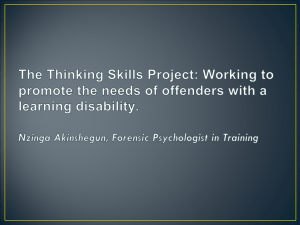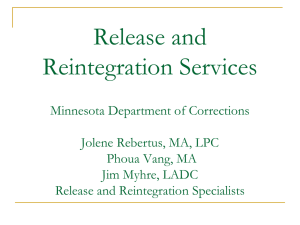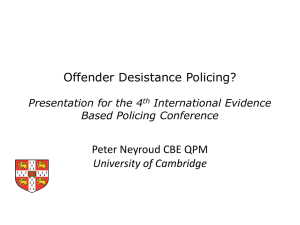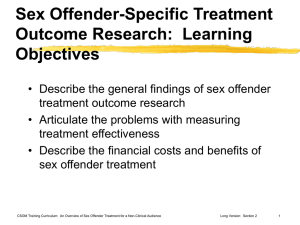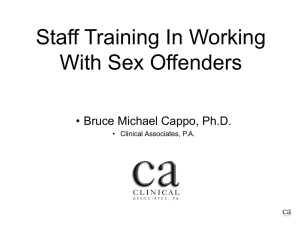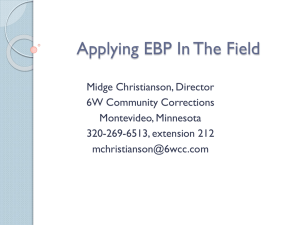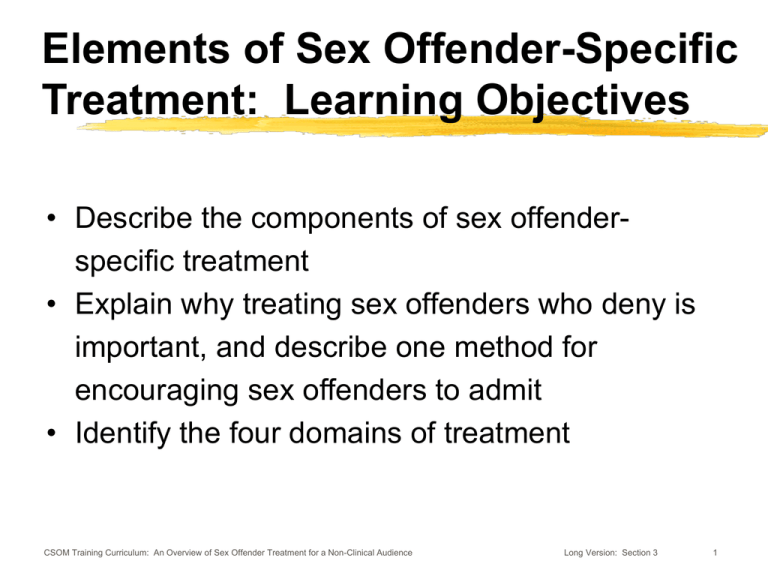
Elements of Sex Offender-Specific
Treatment: Learning Objectives
• Describe the components of sex offenderspecific treatment
• Explain why treating sex offenders who deny is
important, and describe one method for
encouraging sex offenders to admit
• Identify the four domains of treatment
CSOM Training Curriculum: An Overview of Sex Offender Treatment for a Non-Clinical Audience
Long Version: Section 3
1
Learning Objectives (cont.)
• Describe a number of sex offender-specific
treatment methods
• Summarize research findings related to the
length of sex offender treatment and therapist
style variables
• Identify several ethical issues in the treatment of
sex offenders
CSOM Training Curriculum: An Overview of Sex Offender Treatment for a Non-Clinical Audience
Long Version: Section 3
2
Two Facets of Sex Offender
Management: Addressing both
External and Internal Controls
Internal Controls:
External Controls:
• Probation/Parole
Supervision
• Polygraph
Testing
• Registration/
Notification
• Use of
Community
Networks
External
Controls
Internal
Controls
CSOM Training Curriculum: An Overview of Sex Offender Treatment for a Non-Clinical Audience
The Four Domains of
Treatment:
• Sexual Interests
• Distorted
Attitudes
• Interpersonal
Functioning
• Behavior
Management
Long Version: Section 3
3
Characteristics of Sex OffenderSpecific Treatment
•
•
•
•
•
Explicit, empirically-based model of change
Expected to reduce recidivism
Social learning theory-based
Addresses criminogenic needs
Targets factors closely linked to sex offending
(criminogenic needs)
CSOM Training Curriculum: An Overview of Sex Offender Treatment for a Non-Clinical Audience
Long Version: Section 3
4
What Methods are Effective?
•
•
•
•
Cognitive-behavioral techniques
Adult learning theory methods
Positive reinforcement rather than punishment
Respectful confrontation
CSOM Training Curriculum: An Overview of Sex Offender Treatment for a Non-Clinical Audience
Long Version: Section 3
5
Treatment is Skills Oriented
• Skills to avoid sex offending
• Skills to engage in legitimate activities
• “Skills oriented treatment” includes:
• Defining the skill
• Identifying the usefulness of the skill
• Modeling the skill
• Practicing the skill
• Giving feedback
• Practicing the skill again
CSOM Training Curriculum: An Overview of Sex Offender Treatment for a Non-Clinical Audience
Long Version: Section 3
6
How Long Should Sex
Offender Treatment Last?
• Until recently, answers to this question were
based only on opinion—there is now research
that addresses this question
• Different offenders require different lengths of
treatment
• Higher levels of denial, sexual deviancy, and
risk require longer, more intense treatment
CSOM Training Curriculum: An Overview of Sex Offender Treatment for a Non-Clinical Audience
Long Version: Section 3
7
Monitoring and Quality Control of
Treatment are a Must
• Monitoring of:
• Program activities
• Clients
CSOM Training Curriculum: An Overview of Sex Offender Treatment for a Non-Clinical Audience
Long Version: Section 3
8
Treatment of the Denying Sex
Offender
• Denial is common among sex offenders
• But, admitting is vital to treatment
• Sex offenders who do not admit at some point
can’t be treated
• Therefore, treatment of denial is usually
necessary to make a client ready for sex
offender treatment
CSOM Training Curriculum: An Overview of Sex Offender Treatment for a Non-Clinical Audience
Long Version: Section 3
9
Tools for Addressing Denial
• The polygraph—aimed at specific deceptions
• Physiological indications of deception
• Offenders often abandon denial
• Group treatment—targets two issues
• Eliminating cognitive distortions
• Developing victim awareness
CSOM Training Curriculum: An Overview of Sex Offender Treatment for a Non-Clinical Audience
Long Version: Section 3
10
Treating Denial Focuses on its
Complexity
• Many purposes—why offenders are often in
denial
• Multiple pressures to deny
• Denial in various phases of the offense (before,
during, and after)
CSOM Training Curriculum: An Overview of Sex Offender Treatment for a Non-Clinical Audience
Long Version: Section 3
11
Methods to Address Cognitive
Distortions
• Role-play explaining to a victim all the
information he would need to give “informed
consent” to sexual activity
CSOM Training Curriculum: An Overview of Sex Offender Treatment for a Non-Clinical Audience
Long Version: Section 3
12
Methods to Address Cognitive
Distortions (cont.)
• Articulating the thinking errors and cognitive
distortions offenders use to excuse their
behavior
CSOM Training Curriculum: An Overview of Sex Offender Treatment for a Non-Clinical Audience
Long Version: Section 3
13
Increasing Victimization
Awareness
If sex offenders come to understand the harm
they cause, they will be more reluctant to
commit future sex offenses because they will
find it more difficult to disregard the
consequences of their actions to their victims
and others
CSOM Training Curriculum: An Overview of Sex Offender Treatment for a Non-Clinical Audience
Long Version: Section 3
14
Methods to Address
Victimization Awareness
• Videotaped programs of sexual assault victims
• Visits by victims to the treatment group
CSOM Training Curriculum: An Overview of Sex Offender Treatment for a Non-Clinical Audience
Long Version: Section 3
15
Involving Sex Offenders
Formerly in Denial
• Often graduates of the “deniers’ group”
• Emphasis on the positive benefits of
abandoning denial
• “If I can do it, so can you”
CSOM Training Curriculum: An Overview of Sex Offender Treatment for a Non-Clinical Audience
Long Version: Section 3
16
The Culmination of Denier’s
Treatment
• The denier is at last permitted to discuss his
own offense—many are now quite willing to do
so
• Some therapists report that 80% of deniers
admit to the offense when this approach is used
CSOM Training Curriculum: An Overview of Sex Offender Treatment for a Non-Clinical Audience
Long Version: Section 3
17
The Four Domains of Treatment
• Sexual Interests
• Distorted Attitudes
• Interpersonal Functioning
• Behavior Management
CSOM Training Curriculum: An Overview of Sex Offender Treatment for a Non-Clinical Audience
Long Version: Section 3
18
Sex Offender Treatment Goals
and Plans
• Accepting personal responsibility for a complete
sexual assault history
• Improving social, relationship, and assertiveness
skills
• Appropriately managing anger
• Learning about the traumatic effects of
victimization and developing empathy
• Learning to separate anger and power from sexual
behavior
• Developing pro-social support networks
CSOM Training Curriculum: An Overview of Sex Offender Treatment for a Non-Clinical Audience
Long Version: Section 3
19
Sex Offender Treatment Goals
and Plans (cont.)
• Recognizing and changing cognitive distortions
• Identifying and modifying sexual arousal patterns
as appropriate via
• Behavioral interventions and/or
• Medication
• Developing and using interventions to interrupt the
offense cycle
• Adopting non-exploitative, responsible lifestyle
CSOM Training Curriculum: An Overview of Sex Offender Treatment for a Non-Clinical Audience
Long Version: Section 3
20
Sexual Interests—The First
Domain of Treatment
• Deviant sexual arousal is sexual arousal to:
• Non-consenting partners
• Non-age-appropriate partners
• Acts that are abusive in nature
• For many sex offenders, the primary reason
they commit sexual assaults is because they
have deviant sexual arousal
CSOM Training Curriculum: An Overview of Sex Offender Treatment for a Non-Clinical Audience
Long Version: Section 3
21
For Offenders with Deviant
Sexual Arousal
If such arousal can be decreased, the likelihood of
future sex offending will be decreased
Treatment goals include:
• Reduce deviant sexual arousal while
increasing non-deviant sexual arousal
• Increase reactions to the offender’s deviant
behavior as non-offenders react—with
disinterest or revulsion
CSOM Training Curriculum: An Overview of Sex Offender Treatment for a Non-Clinical Audience
Long Version: Section 3
22
Behavioral Intervention to Reduce
Deviant Sexual Arousal
• Based on the idea that deviant sexual arousal is
“learned” behavior and can be unlearned
• Substitutes non-deviant thoughts for deviant
thoughts
• Connects deviant thoughts with non-arousal
CSOM Training Curriculum: An Overview of Sex Offender Treatment for a Non-Clinical Audience
Long Version: Section 3
23
Common Questions
• Can offenders sabotage
this?
• Who is this best suited
for?
• Is this technique
essential?
• Can this technique be
used exclusive of others?
• Yes—but they’re only
hurting themselves
• Offenders with significant
deviant sexual arousal
• No—but some
intervention must
address deviant sexual
arousal
• No
CSOM Training Curriculum: An Overview of Sex Offender Treatment for a Non-Clinical Audience
Long Version: Section 3
24
Pharmacological Interventions to
Address Deviant Sexual Arousal
There are two primary types of medications used
in the treatment of sex offenders:
• Selective Serotonin Reuptake Inhibitors
(SSRIs)
• Antiandrogens—used for what some call
“chemical castration”
CSOM Training Curriculum: An Overview of Sex Offender Treatment for a Non-Clinical Audience
Long Version: Section 3
25
Selective Serotonin Reuptake
Inhibitors
• Commonly prescribed for depression
• Reduce libido (sexual interest)
• They can also reduce aggression, decrease
deviant fantasies, empower people to better
manage their behavior, and reduce the intensity
of compulsive aspects of sexual offending
• Many physicians are knowledgeable of and
comfortable with prescribing such medications
CSOM Training Curriculum: An Overview of Sex Offender Treatment for a Non-Clinical Audience
Long Version: Section 3
26
Antiandrogen Medications
• Drastically reduce testosterone
• Reduce sex drive and the ability to have an
erection
• “Sexual appetite suppressants”
• Examples include Provera and Lupron
• Doctors reluctant to prescribe
CSOM Training Curriculum: An Overview of Sex Offender Treatment for a Non-Clinical Audience
Long Version: Section 3
27
Incidence of Side Effects of
Antiandrogen Medications
•
•
•
•
•
•
•
•
Decreased sperm count—100%
Increased body temperature—100%
Decreased sex drive—95%
Erectile dysfunction—95%
Decreased amount of ejaculate—95%
Weight gain—58%
Increased blood pressure—50%
Fatigue—30%
CSOM Training Curriculum: An Overview of Sex Offender Treatment for a Non-Clinical Audience
Long Version: Section 3
28
Side Effects of Antiandrogen
Medications (cont.)
•
•
•
•
•
Nervousness and/or depression—30%
Hot/cold flashes—29%
Headaches—20%
Nausea—14%
Gall bladder disease (sometimes necessitating
surgery)—13%
• Diabetes—4%
• Phlebitis (can lead to life-threatening pulmonary
emboli)—2%
CSOM Training Curriculum: An Overview of Sex Offender Treatment for a Non-Clinical Audience
Long Version: Section 3
29
Some Physicians are Reluctant
to Prescribe Antiandrogens
• They are not approved by the FDA for the
treatment of sex offenders
• It is outside of normal, clinical practice to
prescribe to men for reduction in sexual
arousal
CSOM Training Curriculum: An Overview of Sex Offender Treatment for a Non-Clinical Audience
Long Version: Section 3
30
Methods of Administration and
Costs: Antiandrogens
• Depo-Provera
• Injected weekly
• $40 per week
• Provera
• Administered orally
• Depo-Lupron
• Injected monthly
• $400 per month
CSOM Training Curriculum: An Overview of Sex Offender Treatment for a Non-Clinical Audience
Long Version: Section 3
31
Is Medication Alone an Effective
Treatment Method?
• Medication that complements the cognitivebehavioral center of treatment can be very helpful
in facilitating treatment—5 to 30% can benefit
• If our goal is to reduce recidivism, and medication
will help maintain an individual long enough to
help him assimilate the cognitive-behavioral
response, it is irresponsible not to use it
• Conversely, given the current body of evidence, it
would be irresponsible to only medicate and not
include a cognitive-behavioral treatment
component
CSOM Training Curriculum: An Overview of Sex Offender Treatment for a Non-Clinical Audience
Long Version: Section 3
32
Distorted Attitudes—The Second
Domain of Treatment
• Purpose—to identify and alter offenders’
justifications for sex offending
• One approach is through cognitive restructuring
• By examining and exposing these thoughts,
justifications, rationalizations, and excuses, the
offender is challenged to understand his faulty
thinking and recognize its distorted, self-serving
nature
CSOM Training Curriculum: An Overview of Sex Offender Treatment for a Non-Clinical Audience
Long Version: Section 3
33
Cognitive Restructuring
Assists offenders to:
• Examine rationalizations, excuses, and
cognitive distortions
• Obtain candid feedback on these distortions
from others
• Heighten awareness of victimization issues
• Recognize the faultiness of his thinking
• Reduce his ability to justify future offending
CSOM Training Curriculum: An Overview of Sex Offender Treatment for a Non-Clinical Audience
Long Version: Section 3
34
Methods of Cognitive
Restructuring
• Examine role of distortions in non-sexual
situations
• Offenders anonymously relate the distortions
they have used in the past
• Role-playing of victim, victim’s parent, long-time
friend of offender, probation/parole agent
• Debrief role plays
CSOM Training Curriculum: An Overview of Sex Offender Treatment for a Non-Clinical Audience
Long Version: Section 3
35
Rationale for Victimization
Awareness/Empathy Training
• Most offenders victimize for selfish gratification
• If sex offenders learn about the true
consequences of their actions for victims, this
decreases their ability to discount the trauma
that their actions create
• Most sex offenders have not learned empathy
• If they learn, they will be less able to ignore the
trauma their victims suffer
CSOM Training Curriculum: An Overview of Sex Offender Treatment for a Non-Clinical Audience
Long Version: Section 3
36
Goals of Victimization
Awareness/Empathy Training
• To understand the pervasive negative effects of
sexual assault on victims and others
• To know the likely consequences of his assaults
on his victims and families
• To learn empathy skills, especially the ability to
empathize with his victims
CSOM Training Curriculum: An Overview of Sex Offender Treatment for a Non-Clinical Audience
Long Version: Section 3
37
Methods of Victimization
Awareness/Empathy Training
• Presentation of information on the typical
trauma to sexual assault victims
• Use of audiovisual materials
• Written assignments
• Group education and confrontation by adult
sexual assault survivors
CSOM Training Curriculum: An Overview of Sex Offender Treatment for a Non-Clinical Audience
Long Version: Section 3
38
Methods of Victimization
Awareness/Empathy Training (cont.)
• Each offender describes his worst offense from the
victim’s perspective
• Introduces his victim by first name and age
• Describes how he accessed and groomed the
victim
• Describes what he did to influence the victim not to
report
• Discusses how the victim is doing now
• Postulates what the victim would like to say to him
or ask him now
CSOM Training Curriculum: An Overview of Sex Offender Treatment for a Non-Clinical Audience
Long Version: Section 3
39
Interpersonal Functioning—The
Third Domain of Treatment
• Why is this important?
• Persons with poor social skills may, out of
frustration:
• Overpower victims, or
• Retreat to the lower stress environment of
children
• Improved social skills can reduce the need to
resort to abusive behavior to interact with others
CSOM Training Curriculum: An Overview of Sex Offender Treatment for a Non-Clinical Audience
Long Version: Section 3
40
The Goals of Increasing
Interpersonal Functioning
To increase social skills in:
•
•
•
•
•
Meeting strangers
Initiating and maintaining conversations
Correctly interpreting non-verbal communication
Developing appropriate non-verbal skills
Understanding appropriate methods of
indicating interest and disinterest
• Managing anxiety
CSOM Training Curriculum: An Overview of Sex Offender Treatment for a Non-Clinical Audience
Long Version: Section 3
41
The Goals of Increasing
Interpersonal Functioning (cont.)
• Appropriate personal disclosure
• Transitioning from social to social-sexual
interactions
• Maintaining friendships
• Respecting women and children
• Understanding the importance of addressing
attention to others beyond one’s self
CSOM Training Curriculum: An Overview of Sex Offender Treatment for a Non-Clinical Audience
Long Version: Section 3
42
Methods of Social Skills
Training
• Presentations on relevant topics
• Role playing various types of social settings
• Behavioral assignments with reports back to
the group
CSOM Training Curriculum: An Overview of Sex Offender Treatment for a Non-Clinical Audience
Long Version: Section 3
43
Rationale for Assertiveness
Training
• Assertiveness increases self-esteem, reduces
guilt and anger, and increases satisfaction in
interpersonal interactions
• Sex offenders often suffer from low self-esteem,
guilt, and anger when they assert themselves
• They often store up slights, humiliations, and
react with inappropriate anger—sometimes
contributing to violent sexual abuse
CSOM Training Curriculum: An Overview of Sex Offender Treatment for a Non-Clinical Audience
Long Version: Section 3
44
Goals of Assertiveness Training
• Learn that the primary purpose of assertiveness
is not to change others’ behavior but rather to
increase self-respect
• Reduce fear, shame, anger, and guilt in
interpersonal interactions
• Increase self-respect and self-esteem
• Improve effective interpersonal interactions
• Teach specific assertiveness skills
CSOM Training Curriculum: An Overview of Sex Offender Treatment for a Non-Clinical Audience
Long Version: Section 3
45
Rationale for Sexual Values
Clarification Training
• Many sex offenders have deficits in sexual
knowledge
• They may commit offenses in part because they
have unreasonable expectations of their sexual
functioning, have high anxiety in sexual
situations, or have had negative experiences
with consenting sexual partners
CSOM Training Curriculum: An Overview of Sex Offender Treatment for a Non-Clinical Audience
Long Version: Section 3
46
Goals of Sexual Values
Clarification Training
• Increase knowledge about basic, healthy sexual
functioning
• Promote positive, respectful attitudes toward
women and children
• Educate about normal sexual attitudes,
behavior, and performance
• Reduce anxiety about sexual matters
• Increase information about sexually transmitted
diseases
CSOM Training Curriculum: An Overview of Sex Offender Treatment for a Non-Clinical Audience
Long Version: Section 3
47
Behavior Management—The
Fourth Domain of Treatment
Sex offending is, by definition, mismanagement
of behavior by the offender. Thus, the purpose
of intervening in this treatment domain is to
assist offenders to manage their behavior in
responsible and non-victimizing ways. We will
discuss two methods:
• Covert Sensitization
• Relapse Prevention
CSOM Training Curriculum: An Overview of Sex Offender Treatment for a Non-Clinical Audience
Long Version: Section 3
48
Goals of Covert Sensitization
• To reduce the attractiveness of sexual assault
by having the offender focus on the negative
social consequences he faces
• To have offenders explore all of the
consequences of their actions—in particular the
negative consequences which offenders so
often refuse to recognize
CSOM Training Curriculum: An Overview of Sex Offender Treatment for a Non-Clinical Audience
Long Version: Section 3
49
Methods of Covert Sensitization
• Offenders identify the chain of thoughts that
lead them to offense behavior
• Offenders are taught to deliberately interject
vivid scenes of the negative consequences they
will face during that chain of thoughts
• Autiotaped homework provides structured
practice sessions for this technique that can be
reviewed by the treatment provider
CSOM Training Curriculum: An Overview of Sex Offender Treatment for a Non-Clinical Audience
Long Version: Section 3
50
Relapse Prevention
• First used in the treatment of alcohol and other
drug abuse
• If behavior could be managed to avoid certain
situations, then relapse was less likely
• Applied now in the treatment of sex offenders
CSOM Training Curriculum: An Overview of Sex Offender Treatment for a Non-Clinical Audience
Long Version: Section 3
51
Rationale for Relapse Prevention
• Sex offenders who believe that treatment will
eliminate their risk for reoffense are more likely
to recidivate
• Offenders who understand that they are never
“cured,” recognize offense precursors, and
avoid high risk thoughts, feelings, and behaviors
are more likely to remain offense-free
CSOM Training Curriculum: An Overview of Sex Offender Treatment for a Non-Clinical Audience
Long Version: Section 3
52
Relapse Prevention Cycle
Abstinence
(Sense of Control, Continued Success Expected)
Seemingly Unimportant Decision?
Yes
No: Prevention
High-Risk Situation
(Sense of control threatened)
Adequate Coping Response
No
Yes: Prevention
Lapse
Abstinence Violation Effect (giving up)
Adequate Coping Response?
No
Yes: Prevention
Relapse (Reoffense)
CSOM Training Curriculum: An Overview of Sex Offender Treatment for a Non-Clinical Audience
Long Version: Section 3
53
Goals of Relapse Prevention
The sex offender must learn:
• That prevention of new offenses is a life-long
process
• That certain situations, thoughts, or chains of
events pose high risk for reoffense
• That seemingly unimportant decisions can lead
to reoffense
CSOM Training Curriculum: An Overview of Sex Offender Treatment for a Non-Clinical Audience
Long Version: Section 3
54
Goals of Relapse Prevention (cont.)
The sex offender must learn the typical sequence
of events that lead to relapse:
•
•
•
•
•
•
Perception of control
Introduction of a negative mood state
Engaging in fantasies of reoffending
Development of a plan to commit the offense
(Often) use of disinhibiting substance
RELAPSE
CSOM Training Curriculum: An Overview of Sex Offender Treatment for a Non-Clinical Audience
Long Version: Section 3
55
Goals of Relapse Prevention (cont.)
The sex offender must learn that:
• If he interrupts this sequence with positive
coping, he can avoid reoffending
• A lapse is the occurrence of any step in the
sequence short of reoffending
• Interrupting the pre-offense behavior cycle is
easiest to do in its early stages
CSOM Training Curriculum: An Overview of Sex Offender Treatment for a Non-Clinical Audience
Long Version: Section 3
56
Methods of Relapse Prevention
• Dispel offenders’ misconceptions about their
reoffense risk—IT’S STILL THERE
• Assess high risk situations
• Evaluate coping skills and strategies
• Design intervention plan to avoid first lapse and
how to prevent a lapse from becoming a
relapse
• Learn self-monitoring of moods and behaviors
CSOM Training Curriculum: An Overview of Sex Offender Treatment for a Non-Clinical Audience
Long Version: Section 3
57
Methods of Relapse Prevention
(cont.)
• Write an autobiography to understand life
patterns that result in offending
• Teach problem-focused coping responses
• Control stimuli that might promote relapse
• Teach the relapse process
• Teach that urges subside with time
• Teach avoidance strategies
CSOM Training Curriculum: An Overview of Sex Offender Treatment for a Non-Clinical Audience
Long Version: Section 3
58
Methods of Relapse Prevention
(cont.)
• Teach relapse rehearsal
• Promote lifestyle changes
• Identify pro-social methods to express power
CSOM Training Curriculum: An Overview of Sex Offender Treatment for a Non-Clinical Audience
Long Version: Section 3
59
Adjunctive Therapies
• Marital and family therapy
• Family education seminars and couples’
groups
• Substance abuse treatment
• Educational/vocational supports
• Individual therapy (usually for other issues)
CSOM Training Curriculum: An Overview of Sex Offender Treatment for a Non-Clinical Audience
Long Version: Section 3
60
Ethical Practice Standards
• Balancing the safety of the community with the
offender’s privacy
• Informed consent
• Association for the Treatment of Sexual
Abusers (ATSA) is the major professional
organization that speaks to ethical practice
standards in this field
• ATSA has issued a “Code of Ethics” as well as
practice standards and guidelines
• www.atsa.com
CSOM Training Curriculum: An Overview of Sex Offender Treatment for a Non-Clinical Audience
Long Version: Section 3
61
A Major Ethical Issue: Informed
Consent
At a minimum, sex offenders entering treatment
should have spelled out to them—preferably in
writing:
• The purpose and nature of treatment
• Its expected duration
• Its anticipated benefits, costs, and risks
• Limitations of confidentiality
CSOM Training Curriculum: An Overview of Sex Offender Treatment for a Non-Clinical Audience
Long Version: Section 3
62
Treatment Provider Characteristics
• In the past, sex offender treatment has often
involved a punitive treatment style
characterized by aggressive verbal
confrontation between offender and therapist
• Several studies examine how therapist styles
affect the success of treatment
CSOM Training Curriculum: An Overview of Sex Offender Treatment for a Non-Clinical Audience
Long Version: Section 3
63
Treatment Provider
Characteristics (cont.)
Three treatment targets seem to be better
achieved with the use of treatment delivered in a
warm, empathic, genuine style
• Reduction of mistrust of women
• Reduction in sense of entitlement to sexual
gratification
• Reduction in impulsivity
CSOM Training Curriculum: An Overview of Sex Offender Treatment for a Non-Clinical Audience
Long Version: Section 3
64
Summary
We’ve reviewed sex offender treatment
• History, current practices, most effective methods,
particular techniques and style, and length of treatment
The four domains of sex offender-specific treatment:
•
•
•
•
Sexual Interests
Distorted Attitudes
Interpersonal Functioning
Behavior Management
Your heightened understanding of sex offenderspecific treatment will enable you to work more
effectively and collaboratively with treatment providers
CSOM Training Curriculum: An Overview of Sex Offender Treatment for a Non-Clinical Audience
Long Version: Section 3
65


